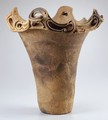
 |
Japan, Middle Jomon period Storage Jar About 3000-2000 B.C. Earthenware with modeled and impressed decor 22 inches wide, 21-1/4 inches high The Ethel Morrison Van Derlip Fund 82.9.1 |
The storage jar is remarkably regular and SYMMETRICAL, a form typically accomplished with the aid of a potter's WHEEL. But it was made well before the introduction of the wheel in Japan. The artist built up the vessel from a base using long coils of clay rolled by hand, pressed together, and formed into a distinctive shape. Imaginative handles and rims were also shaped by hand and applied at the top.
Jomon potters used a coarse-textured ALLUVIAL clay that was available near their dwelling sites. As with the Hopi-Tewa seed jar discussed in this unit, sand or crushed stone was added as a TEMPER to ensure that the pots dried evenly, without cracking.
Jomon literally means "cord markings." The name comes from the scratchings or impressions of cord or matting which decorated the outer surface of the vessels. The potter made the patterns on this pot by rolling twisted cord or rope over the surface of the shaped clay. On other pots, patterns were created with impressions of bamboo sticks, seashells, and even fingernails.
To make them more durable, unglazed Jomon wares were stacked in simple open pits and "cooked" by wood fires built around and over them. The fire was fed continuously for about an hour and then allowed to die down. The low firing temperatures ranged from 600° to 800° C. As can be seen on this jar, surfaces became marked with black spots caused by REDUCTION, or the lack of oxygen due to poor combustion.

Key ideas.
Where does it come from?
What does it look like?
How was it used?
How was it made?
Discussion questions.
Additional resources.
Select another piece.